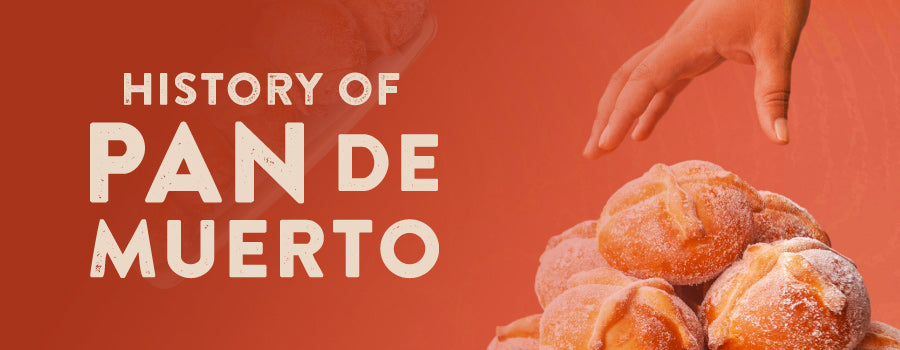HISTORY OF PAN DE MUERTO & DÍA DE LOS MUERTOS

Pan de Muerto is the dessert of the Fall-season for many Mexican households during Día de Muertos. It's sweet, fluffy, coated in sugar or sesame seeds with a light orange zest. It pairs beautifully with a Chocolate Mexicano or evening cafecito. Most importantly, they adorn family ofrendas as sweet offerings to the ancestors.
Where do these iconic breads originate? How true are the legends surrounding its origins? Let's find out!
THE PRE-HISPANIC ROOTS
Often, you will find resources claiming that prior to the arrival of the Spanish, people would consume human hearts baked in amaranth in place of the bread we are familiar with today. This, however, is a myth with no actual credibility behind it. Tall tales like these were spread to Europe by conquistadors who aimed to justify the colonization of Latin America by inventing and exaggerating indigenous practices.
In the case of Pan de Muerto, actual indigenous inspirations for the modern bread may be linked to foods like the papalotlaxcalli, a butterfly shaped tortilla made to honor women who died during childbirth. Other practices included using votive tamales and amaranth breads as offering to the dead, specifically during the harvest festivals held around August. These festivals would later be moved by the Catholic Church to November 1st, All Saint's Day. The same festivities that once took an entire month were now condensed to a single day, el Día de los Muertos. This is where the modern pan de muerto begins to take shape.

In the most common Pan de Muerto variations, the bun is decorated with symbolic imagery of the dead. A round ball at the top representing a skull, long bone-shaped pieces representing the skeleton, and often the ends are allowed to droop into a tear shape – the tears of the mother deity Chimalma as she mourns.
CONTEMPORARY PAN DE MUERTO
Today, there are many varieties of Pan de Muerto. The designs and recipes vary by region, community, and sometimes by family. The most recognizable design, described previously, is a testament to how the celebration of ancestors has changed and evolved throughout the centuries.
With the arrival of egg, wheat, sugar, and oranges, the Catholic Church imported roman traditions of consuming bread in honor of the dead. As indigenous communities were already accustomed to preparing offerings for the ancestors, the Church was successful in replacing amaranth and corn with the European goods. They were not successful, however, in removing the symbolism and imagery that was so integral to indigenous honorings of the dead.
Sugar skulls, bread skulls, faces painted with skulls – the skull is the icon of honoring the dead in mesoamerica with a rich history dating thousands of years. This history is still present today and defines the Dia de Muertos celebrations in the US and Mexico.
WHERE TO GET PAN DE MUERTO
Luckily, Pan de Muerto is very easy to find during the Fall-season! La Monarca Bakery serves fresh-baked pan de muerto as well as catering trays of the mini variety online!
BIBLIOGRAPHY
Martínez, Alonso (2020-10-01). "El (supuesto) origen caníbal del Pan de Muerto". GQ (in Mexican Spanish). Retrieved 2022-07-01.
"La historia del pan de muerto". Revista Chilango (in Spanish). 2014-10-29. Retrieved 2022-07-01.
"El Pan de muerto, este es su origen y sus variedades en México". W Radio México (in Mexican Spanish). 2020-10-29. Retrieved 2022-07-01.
Norget, Kristin (2021-07-14). "Popular-Indigenous Catholicism in Southern Mexico". Religions. 12 (7): 531. doi:10.3390/rel12070531. ISSN 2077-1444.

